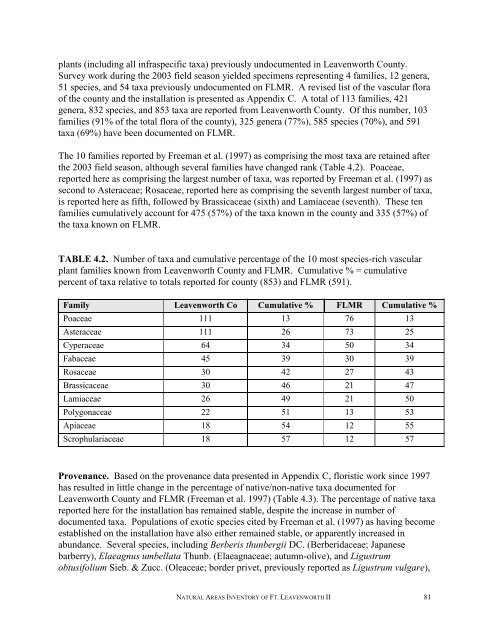A Natural Areas Inventory of the - Kansas Natural Heritage Inventory ...
A Natural Areas Inventory of the - Kansas Natural Heritage Inventory ...
A Natural Areas Inventory of the - Kansas Natural Heritage Inventory ...
You also want an ePaper? Increase the reach of your titles
YUMPU automatically turns print PDFs into web optimized ePapers that Google loves.
plants (including all infraspecific taxa) previously undocumented in Leavenworth County.<br />
Survey work during <strong>the</strong> 2003 field season yielded specimens representing 4 families, 12 genera,<br />
51 species, and 54 taxa previously undocumented on FLMR. A revised list <strong>of</strong> <strong>the</strong> vascular flora<br />
<strong>of</strong> <strong>the</strong> county and <strong>the</strong> installation is presented as Appendix C. A total <strong>of</strong> 113 families, 421<br />
genera, 832 species, and 853 taxa are reported from Leavenworth County. Of this number, 103<br />
families (91% <strong>of</strong> <strong>the</strong> total flora <strong>of</strong> <strong>the</strong> county), 325 genera (77%), 585 species (70%), and 591<br />
taxa (69%) have been documented on FLMR.<br />
The 10 families reported by Freeman et al. (1997) as comprising <strong>the</strong> most taxa are retained after<br />
<strong>the</strong> 2003 field season, although several families have changed rank (Table 4.2). Poaceae,<br />
reported here as comprising <strong>the</strong> largest number <strong>of</strong> taxa, was reported by Freeman et al. (1997) as<br />
second to Asteraceae; Rosaceae, reported here as comprising <strong>the</strong> seventh largest number <strong>of</strong> taxa,<br />
is reported here as fifth, followed by Brassicaceae (sixth) and Lamiaceae (seventh). These ten<br />
families cumulatively account for 475 (57%) <strong>of</strong> <strong>the</strong> taxa known in <strong>the</strong> county and 335 (57%) <strong>of</strong><br />
<strong>the</strong> taxa known on FLMR.<br />
TABLE 4.2. Number <strong>of</strong> taxa and cumulative percentage <strong>of</strong> <strong>the</strong> 10 most species-rich vascular<br />
plant families known from Leavenworth County and FLMR. Cumulative % = cumulative<br />
percent <strong>of</strong> taxa relative to totals reported for county (853) and FLMR (591).<br />
Family Leavenworth Co Cumulative % FLMR Cumulative %<br />
Poaceae 111 13 76 13<br />
Asteraceae 111 26 73 25<br />
Cyperaceae 64 34 50 34<br />
Fabaceae 45 39 30 39<br />
Rosaceae 30 42 27 43<br />
Brassicaceae 30 46 21 47<br />
Lamiaceae 26 49 21 50<br />
Polygonaceae 22 51 13 53<br />
Apiaceae 18 54 12 55<br />
Scrophulariaceae 18 57 12 57<br />
Provenance. Based on <strong>the</strong> provenance data presented in Appendix C, floristic work since 1997<br />
has resulted in little change in <strong>the</strong> percentage <strong>of</strong> native/non-native taxa documented for<br />
Leavenworth County and FLMR (Freeman et al. 1997) (Table 4.3). The percentage <strong>of</strong> native taxa<br />
reported here for <strong>the</strong> installation has remained stable, despite <strong>the</strong> increase in number <strong>of</strong><br />
documented taxa. Populations <strong>of</strong> exotic species cited by Freeman et al. (1997) as having become<br />
established on <strong>the</strong> installation have also ei<strong>the</strong>r remained stable, or apparently increased in<br />
abundance. Several species, including Berberis thunbergii DC. (Berberidaceae; Japanese<br />
barberry), Elaeagnus umbellata Thunb. (Elaeagnaceae; autumn-olive), and Ligustrum<br />
obtusifolium Sieb. & Zucc. (Oleaceae; border privet, previously reported as Ligustrum vulgare),<br />
NATURAL AREAS INVENTORY OF FT. LEAVENWORTH II 81


